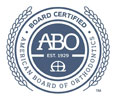Braces
What are the ways braces straighten crooked teeth?
Braces consist of two major parts - single brackets placed on each tooth, and the archwire(s) that links them. Braces employ the use of steady but mild pressure on the teeth, which after a length of time, realigns the teeth. Brackets are made of ceramic or metal and the archwire that links them is formed into a shape that resembles an ideal bite. This is to say that the archwire is bent to the shape you want your teeth to take after treatment is completed. Throughout the duration of your orthodontic treatment, your braces are constantly working.
The archwire passes through the brackets, and as it tries to resume its former shape, the movement translates to pressure that moves the teeth. For illustration purposes, imagine your tooth within your jawbone. If the archwire applies pressure on one side of the tooth, the bone on the other side will shift. As the bone shifts, the tooth will also shift with it, thereby creating room for the growth of new bone.
In reality, the physics, physiology, and mechanics of tooth mobility are complicated, and require years of training to determine the correct and safe amount of pressure needed to achieve tooth movement without adversely affecting the tooth root, gums, and bone. Every applied force has an equal and opposite force which must be either utilized or eliminated. Detailed study is carried out on the way bone develops naturally. This will help determine whether to encourage or prevent some growth methods in growing patients. In addition, care must be taken in choosing the right angle and teeth positioning so that lip support and the shape of soft tissue are not adversely affected.
The shape of the bone, its health and that of the supporting tissues of the teeth must be studied very well in order to determine the type of bracket most suitable for the patient. Dr. Waters may strengthen the braces further with more intricate segmented wire, rubber bands, elastic chains, or even titanium springs, in addition to the standard archwire.
Different Types of Braces
The conventional metal braces are the most popular of all types of dental braces available today. They are smaller and quite popular with younger patients who have the choice of making their braces unique, by choosing their preferred colored rubber bands for a colorful smile.
The clear ceramic braces used to be popular too, until they became susceptible to staining. They have since been replaced with the now newest type of braces - the artificial sapphire crystal brackets.
These braces are rugged and as transparent as glass. They reflect the color of the teeth, thereby appearing almost invisible to the eye. They are most suitable for use on the top teeth and blend better with the teeth, unlike other types of white brackets. These premium qualities make it more expensive.







